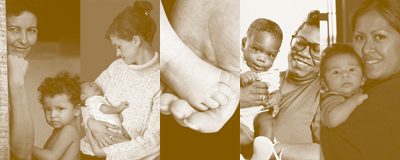|
|
 |
Home > Healthy Living
> Make Every Mother and Child Count > Strategies
Strategies to Protect and Improve Maternal and Child Health

Below are
selected public health strategies to protect and improve maternal and
child health.
LINKS ON
THIS PAGE
Birth Defects and Developmental Disabilities
Cancer
Immunizations
Injury
Nutrition
Pregnancy
Sexually Transmitted Diseases (STDs and HIV/AIDS)
Smoking and Tobacco
Birth Defects and Developmental Disabilities
- CDC
estimates that 50-70% of two common and serious birth defects – spina
bifida and anencephaly - could be prevented if all women of childbearing
age consumed 0.4 mg (400 micrograms) of folic acid daily before and during
early pregnancy.
Folic Acid
Recommendations
http://www.cdc.gov/ncbddd/folicacid/health_recomm.htm
- Women
should not drink alcohol at any time during pregnancy. There is no known
safe amount of alcohol to drink while pregnant, and there also does not
appear to be a safe time to drink during pregnancy, either. Fetal alcohol
syndrome is a condition characterized by abnormal facial features, growth
retardation, and central nervous system problems and can occur if a woman
drinks alcohol during pregnancy.
Fetal Alcohol Syndrome (FAS)
http://www.cdc.gov/ncbddd/fas/
Cancer
- Screening
women using the Papanicolaou (Pap) test is an important strategy that can
prevent cervical cancer from developing most of the time by finding
lesions at an early stage when they can be removed before they become
cancer.
Cervical Cancer
and Pap Test Information
http://www.cdc.gov/cancer/nbccedp/info-cc.htm
Immunizations
- Vaccines
work to safeguard children [and others] from illnesses and death caused by
infectious diseases. Vaccines protect children by helping prepare their
bodies to fight often serious, and potentially, deadly diseases.
How
Vaccines Prevent Disease
http://www.cdc.gov/vaccines/vac-gen/howvpd.htm
Injury
- Child
safety seats reduce the risk of death in passenger cars by 71% for infants
and by 54% for toddlers ages 1 to 4 years. For children 4 to 7 years,
belt-positioning booster seats reduce injury risk by 59% compared to
safety belts alone.
Child
Passenger Safety: Prevention Strategies
http://www.cdc.gov/ncipc/factsheets/childpasprevention.htm
Nutrition
-
Breastfeeding is the healthiest choice for mother and baby. A mother's
milk has just the right amount of fat, sugar, water, and protein that is
needed for a baby's growth and development. Most babies find it easier to
digest breast milk than they do formula. Breast milk has agents (called
antibodies) in it to help protect infants from bacteria and viruses and to
help them fight off infection and disease.
Having a Healthy Pregnancy
http://www.cdc.gov/ncbddd/bd/abc.htm
Breast Feeding: Best for
Baby, Best for Mom
http://www.womenshealth.gov/Breastfeeding/ (Non-CDC site)
Pregnancy
- Prenatal
care is medical care provided to a pregnant woman to prevent complications
and decrease the incidence of maternal and prenatal mortality. Inadequate
use of prenatal care has been associated with increased risk for low
infant birth weight, premature births, neonatal mortality, infant
mortality, and maternal mortality.
Prenatal Care: National Center for Health Statistics Definitions
http://www.cdc.gov/nchs/datawh/nchsdefs/prenatalcare.htm
Sexually Transmitted Diseases (STDs and HIV/AIDS)
- For the
prevention of perinatal HIV transmission, a key strategy is universal,
routine HIV screening of all pregnant women as early as possible during
pregnancy.
Perinatal HIV Prevention Program: Background
http://www.cdc.gov/hiv/projects/perinatal/background.htm
- Pregnant
women should be screened on their first prenatal visit for sexually
transmitted diseases which may include chlamydia, gonorrhea, hepatitis B,
hepatitis C, HIV, and syphilis.
STDs and
Pregnancy
http://www.cdc.gov/std/STDFact-STDs&Pregnancy.htm
Smoking and Tobacco

 This site contains documents in PDF format. You will need Adobe Acrobat Reader
to access the file. If you do not have the Acrobat Reader, you may download a
free copy from the
Adobe Web site.
This site contains documents in PDF format. You will need Adobe Acrobat Reader
to access the file. If you do not have the Acrobat Reader, you may download a
free copy from the
Adobe Web site.
Home | Site Map |
Contact Us
Privacy Policy |
Disclaimer | Accessibility
CDC Home |
Search |
Health Topics A-Z
This page
last reviewed
April 15, 2005
This page last updated
March 12, 2008
URL: http://www.cdc.gov/women/owh/worldhd/strateg.htm
US
Department of Health and Human Services
Centers for Disease Control and Prevention
Office of Women's Health
|


